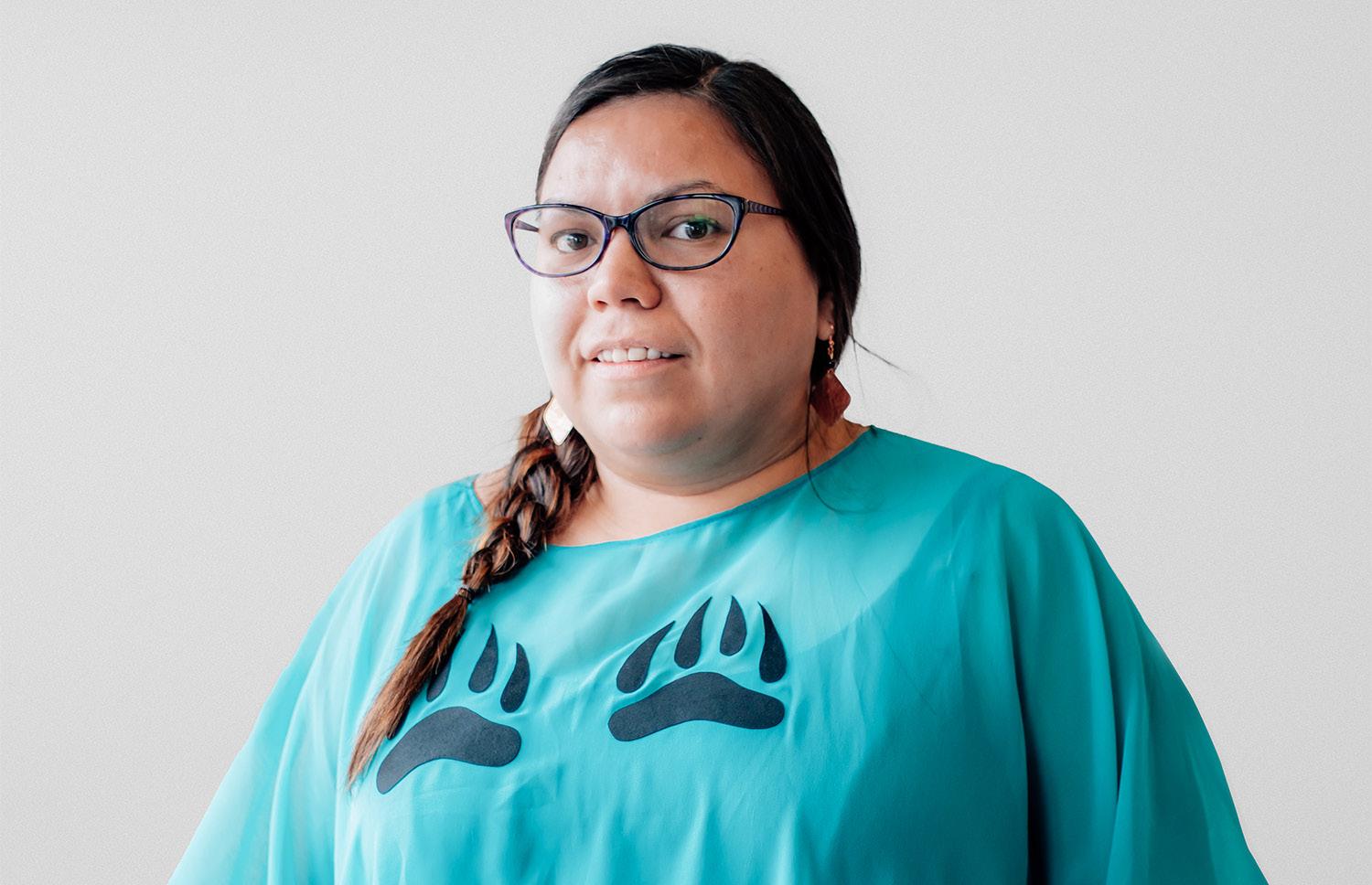
11 minute read
Culture & Heritage – Sandra Marion
Culture & Heritage
Director Report
Sandra Marion
Culture & Heritage Director Dẕenēs hoti’e, Tahltans, the Culture & Heritage Department had the opportunity to support the ancestral remains archaeology work that occurred in territory last summer. In July 2022, we were able to send Lesli Louie and Kianna Quigley to Galore Creek to participate in Resources Information Standard Committee (RISC) Training to become archaeology monitors. Once Lesli completed the RISC training, we were able to send her out on permitted archaeological work with consulting firms that were hired by proponents. During this time, we had some locals observe ancestral remains eroding from the ground and at risk of further disturbance. Luckily, based on their location, the BC Archaeology Branch told us we could determine how we wanted to relocate these remains. Once the team collected the remains we held a burial ceremony as we relocated them to a safer area. You can read more about this endeavour in Lesli’s article that speaks to her experiences. We understand the BC Archaeology Branch standards are much lower than what we would like to see and differ from how we handle our belongings from our ancestors that are found in our territory. The Culture & Heritage Department is looking to partner with the Lands Department to create an Archaeology Division under both our departments. We have spoken to qualified professionals who have influenced the BC Archaeology Branch’s standards for other Indigenous Nations within BC and have experience setting the bar much higher regarding locating, handling, and storing our ancestors’ belongings as they are found out on the land. We will, of course, consider all the work that was done by our predecessors regarding archaeology.
We are currently in discussions with Cordillera Archaeology and other consulting firms about hosting RISC Training in community in the spring. We want to build up our team of archaeology/cultural monitors in territory during the warmer months. Please keep your eye open for postings in the future to sign up for this course.
In September we were able to host two-thirds of the first round of Tahltan place names work since 1980s interviews and the Land Use Study work. We still need to meet in Iskut with our Elders who would like to participate there. We have been able to provide maps and recording equipment to record these events. We will be looking to continue with place names work throughout the year, to make it a more common practice. We sure enjoy spending time with our Elders, and we are grateful for the knowledge they are willing to share with us. We will also be budgeting and planning out how to go about interviewing Elders who no longer reside in the territory. We know we have a large amount of untapped knowledge that rests in the hands of Elders who live across BC, and western Canada. We hope to be able to start reaching everyone sooner rather than later.
Several documents are being drafted by the Culture & Heritage Department that will require engagement with a culture and heritage committee. I am currently working on drafting the terms of reference for this committee and I will share a post to update our Tahltan membership on when they can submit their expressions of interest to be on this committee. I will also include the requirements that we would like to fulfill through this committee work on that said poster.
The Dease Lake School dance group has hit the ground running. We have designed a logo with Christina Callbreath for the dancers. With this logo we plan on developing some swag for when the dance group is away representing the Nation. We look forward to including them on trips to specific events as the calendar year unfolds.
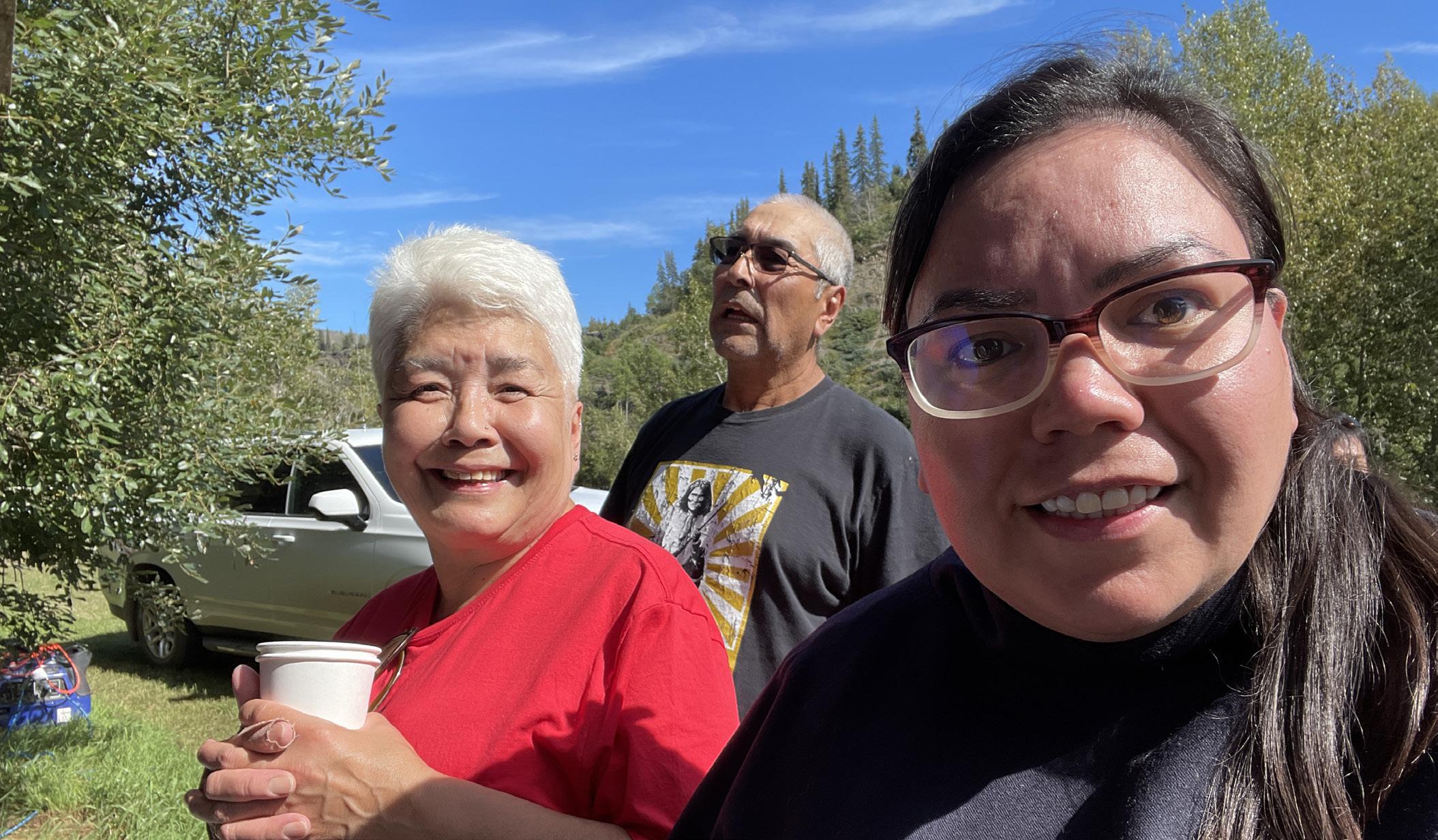
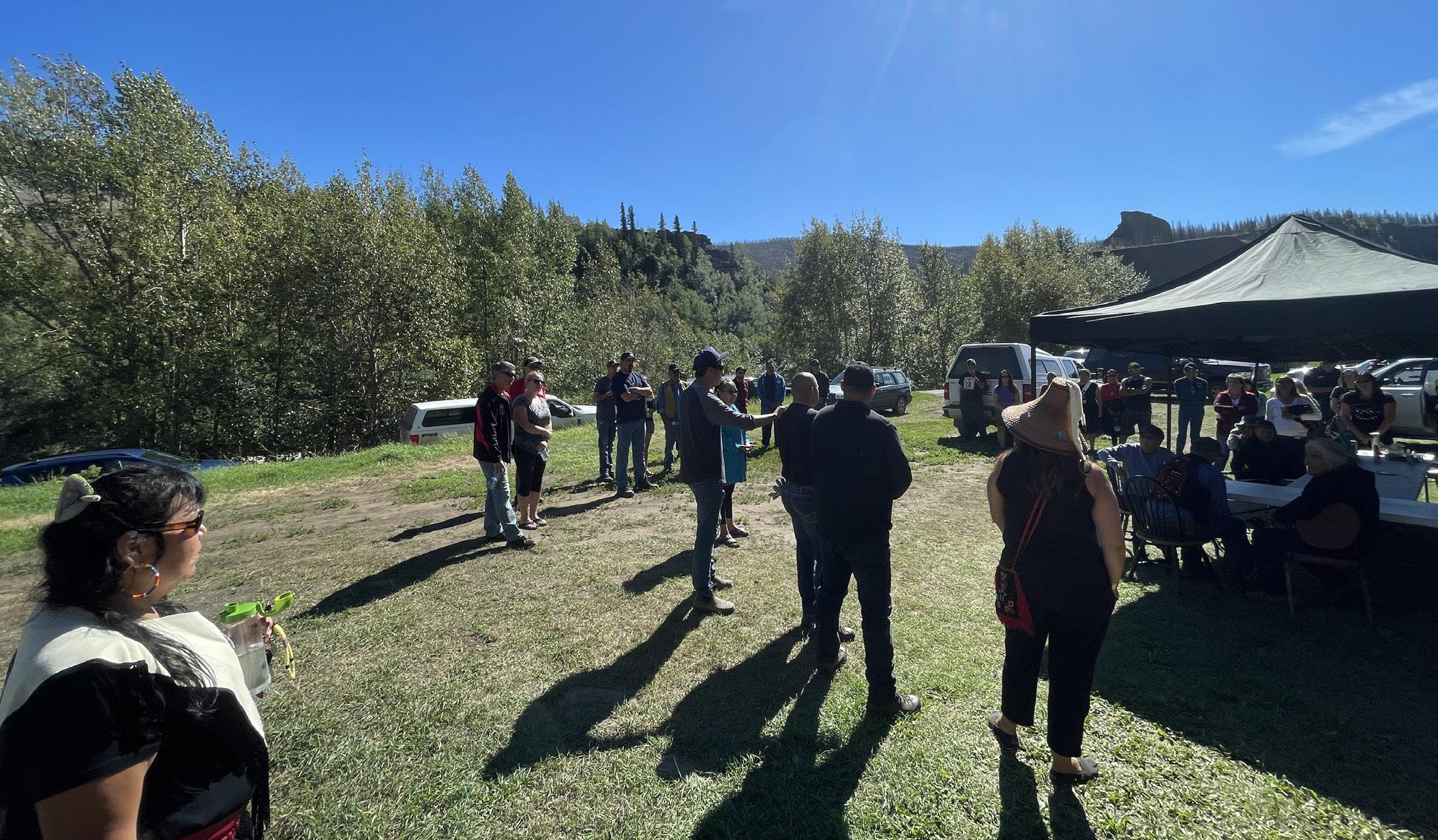
Top: June Louie and Sandra Marion at Telegraph Creek, attending the ancestral remains burial ceremony.
Bottom: Ancestral remains burial ceremony at Telegraph Creek.
Lesli Louie: My Archaeology Experience
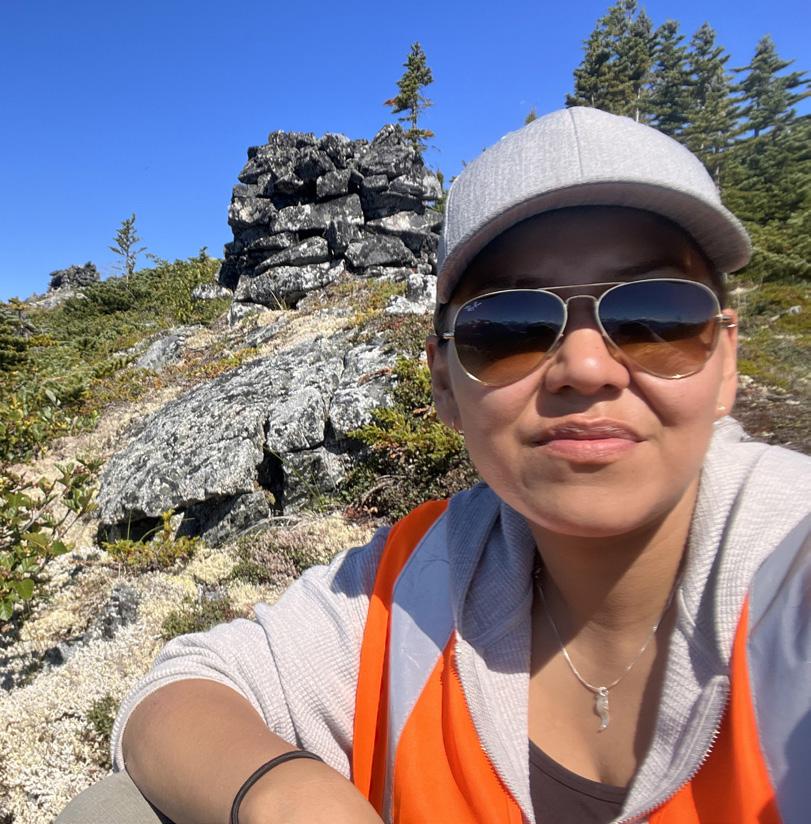
Lesli Louie
Dẕenēs hoti’e. Didenek’eh Dagay ush’yē. Lesli Louie ush’yē.
The highlight of my summer was in August. I had the best two-week experience. I have always wanted to be an archaeologist and I enjoy watching the series Wild Archaeology. I love seeing all the cool artifacts and how archaeology connects us to history and tells us so much about the people of the land. One of my wishes was to work in this field and being able to do it on our land and learn my history while at it, I was honoured; it is worth more than silver and gold. I wish to continue learning and inspire others as well.
In July, I was offered the opportunity to take the BC Provincial Resources Information Standards Committee (RISC) Archaeology training course with others in Galore Creek. Later that summer, Kleanza Consulting, an archaeology firm invited me to join them to work in the field in Galore. In my first helicopter ride this year, it was amazing to be high up in the clouds and above the peaks; we sure have a beautiful country. Rolling mountains, jagged mountains, and hilly mountains; with beautiful glaciers in between and the blue hues of the glacier-fed lakes. I can see why our people fought hard for our land; lots of good food, medicine, berries, and water resources. Dah nene łān konelīn!
Our first week of work was pretty damn exciting. We did some hiking and digging around in the Round Lake Valley. Our teachings came into effect the following day. We caught a helicopter ride and had to do a toe-in on the mountain side on one of the mountains above the confluence of the Scud and Stikine Rivers.
We had some notes from the Tahltan Ancestral Study (TAS) data on some cairns in the area, given by my great uncle, Jackie Williams. Well, that morning, we found them, and we were super stoked. Questions pondered in my mind. I wondered how old these were, how long ago they had been built, how long it took, and why they were built. These boulders were about forty to sixty pounds each and different shapes and sizes, all in five-foot-long by five-foot-wide piles, each about three to four feet high. These were probably all packed up the mountain side by our people hundreds and maybe thousands of years ago. We found about seven of them that day and were so happy to document and record the petroforms.
What a view it was from the mountain. I could see the vast beauty our land holds. I was in awe with the sounds of nature, just soaking it all in. Just hearing the whistles from groundhogs and seeing all the berries in abundance makes me realize how rich we are with what the land can offer us. It felt pretty empowering to be standing where our ancestors once stood. We asked the pilot if we could take some photos and we found even more cairns!
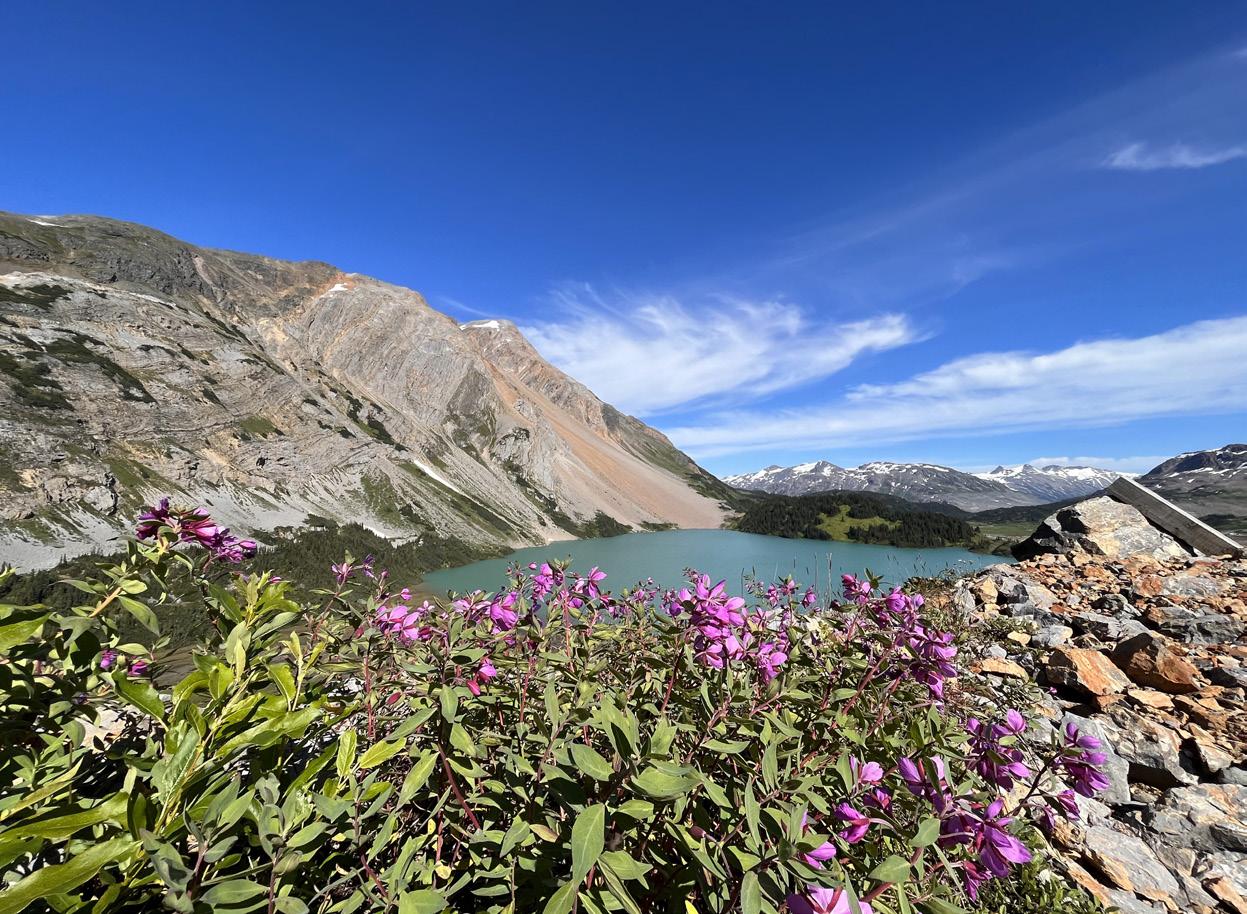
Above: Beautiful Round Lake.

We counted about twenty (including the ones we had found earlier that day). There was a rock wall, possibly used as a hunting blind. It was about twenty feet long and two feet wide, and four feet high. It was incredible! I was so enthralled that time flew by, and I did not want to quit working. But we had to wait until the following day. It was quitting time. The next day our groups joined together to work on the site; measuring, digging, sifting, and looking for lithics and other materials left behind by our ancestors. We counted each cobble and stone, filling in outfield notes as we went along.
The night before, our team lead, Kay Jollymore, got a call from the Culture & Heritage Director about Ancestral Remains (AR). A local had discovered a skull and humerus bone sticking out of the ground. These were eroding from a bank above a road and were at risk of more exposed over time. We were asked to assess and help with the find and we were happy to reply and offer our services. After hearing the news, we broke into groups again and I had a fantastic crew: Kevin Haugrud, Suzy Carruthers, and myself. We got packed and ready to hit the road, bound for Tlēgōhīn (Telegraph Creek).
It was a nice sunny day and very humid. I acted as an archaeologist but also as the tour guide. I showed them the mountains I knew the names of along the way, and our beautiful land, including the lakes, rivers, and views. We got to Tahltan and waited for Chief Carmen McPhee to join us. I told them about and showed them Tses’kiye Chō Kime (Big Crow House) and Dediye Ts’ede (Groundhog Blanket) and shared the stories of how they came to be. After the Chief arrived to show us where the AR were located, we discussed the protocols and smudged before going in to do our site assessment; then we planned for the coming days. Later, we went into town to check-in to our motel rooms at the good old Stikine Riversong. We unloaded our gear and continued our tour down the road to Six
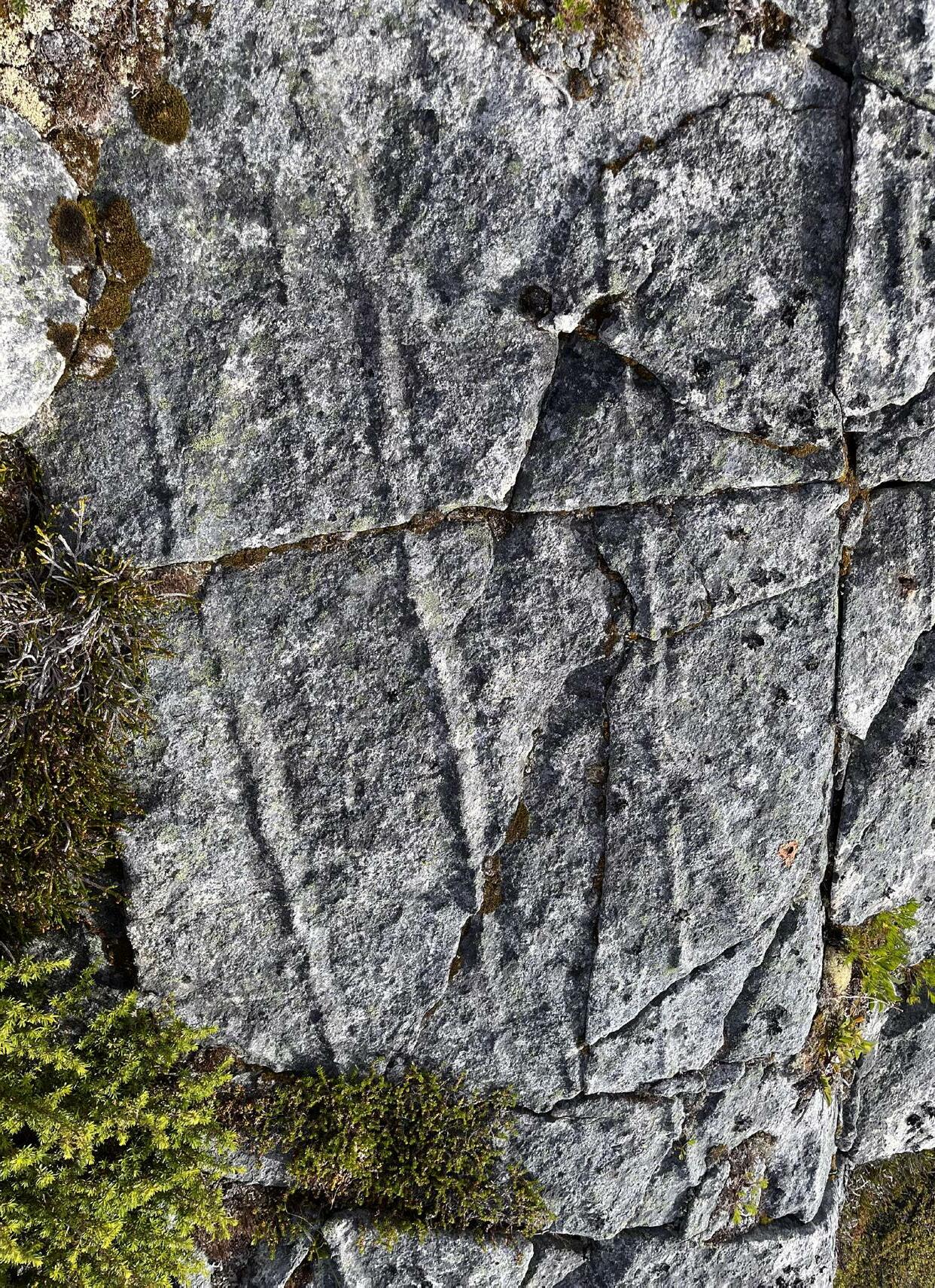
Above: Just above the confluence of Scud and Stikine rivers.
Bottom: Rock transitioning from sedimentary to metamorphic.
Mile. I wanted to show them the petroglyph marker on the river side. A Tlingit marker from the agreement that we (the Tahltans) had with Chief Shakes, the petroglyph stated that he could fish up here in our territory. We had to dig it out as it had been buried by the river rising and was just peeking out. Our job was done quickly, as we had some help. It was a nice evening.
The next day the real work started at nine in the morning when we got out to the site. We started a bit of the excavation work and did some sketches every five to ten centimetres. The day went by quickly and we had some family members from the community come help and support us. After work, we ate dinner then we had the grand tour from the mayor of Old Town, Uncle Lee Marion. He showed around us and taught us so much history from the area. You can really feel and see the pride; it was awesome to share and witness.
We continued over the next few days, carefully digging, sifting, and moving cobbles and boulders ten cents at a time. We found obsidian flakes, red ochre, and a few shell casings, here and there throughout the excavation, probably set out as offerings over time. It took us a total of four days and we did it as carefully and respectfully as we could, smudging going in and out. On the final day we were able to move the ancestors into their new caskets and transfer them to a safer area.
There were two of our ancestors buried head-to-head, with one facing upstream and the other downstream. It was beautiful. We anticipate one of them to be a woman who was buried with a twisted copper necklace that had dentalium shells and abalone. She also had a piece of copper in her mouth. To me, maybe this signifies that they wanted her to be wealthy in the afterlife. I think she was wrapped in some skin and bark, possibly balsam and birch. She must have been someone of high status as she had beautiful jewelry.
It was a good day that day. We saw a few eagles and had more support and family come out. Mēduh chō! There was a beautiful rainbow, sideways (kind of like the northern lights), and a light sprinkle of rain. It almost felt like a thank you. I know we all did good by them.
Later that day, we sat with some family and friends to share our experience and hiked around a bit, but we were also so exhausted from all the digging and
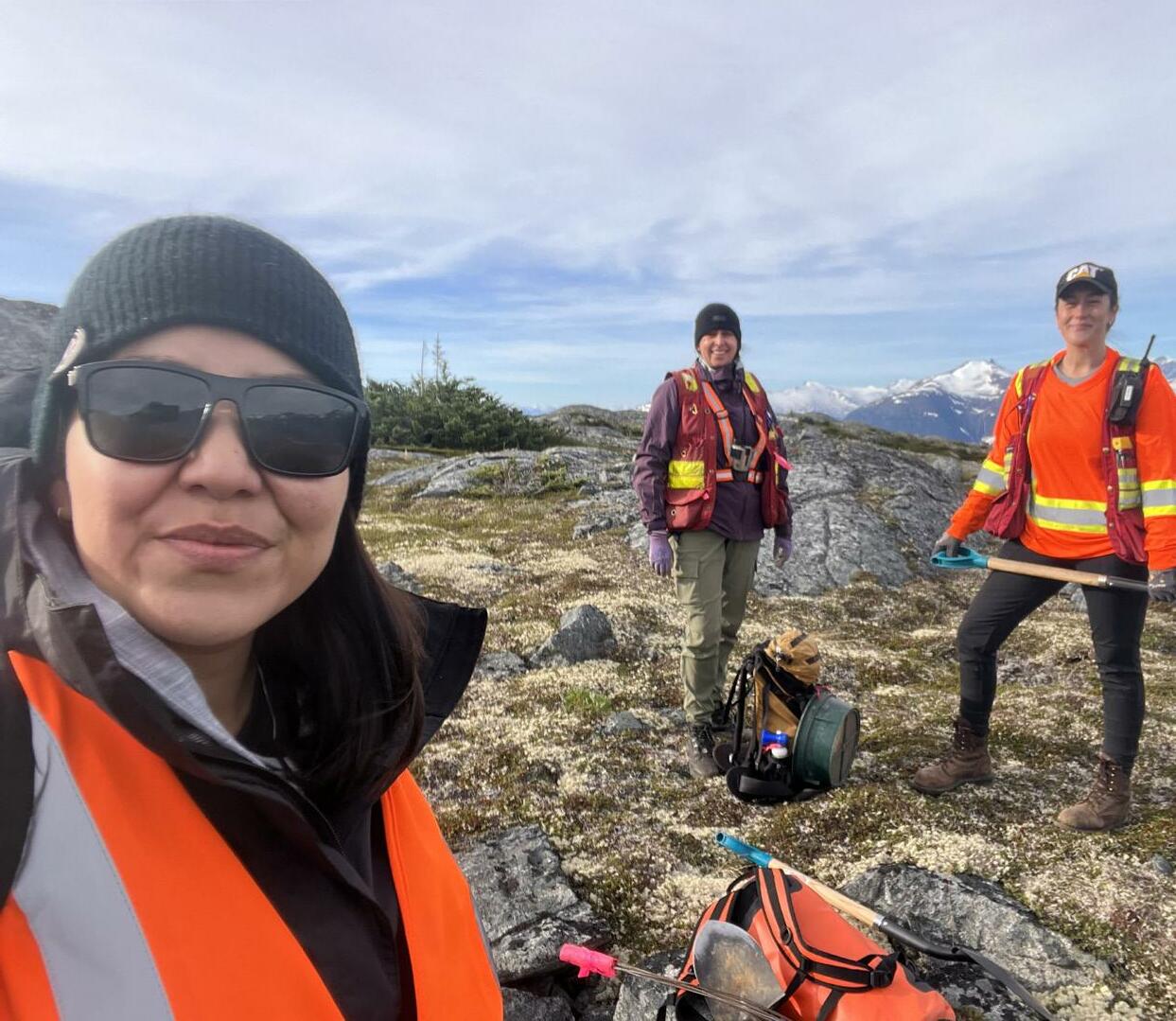
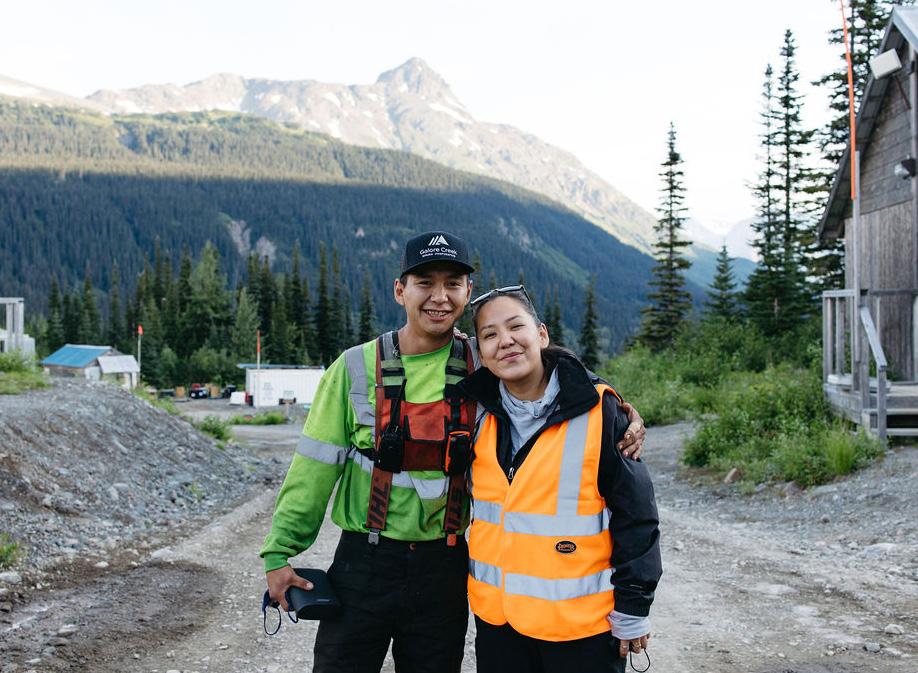
Above: Lesli Louie, Kay Jollymore, and Suzy Carruthers.
Bottom: Dylan and Lesli Louie working in the same camp, Galore Creek Mine.

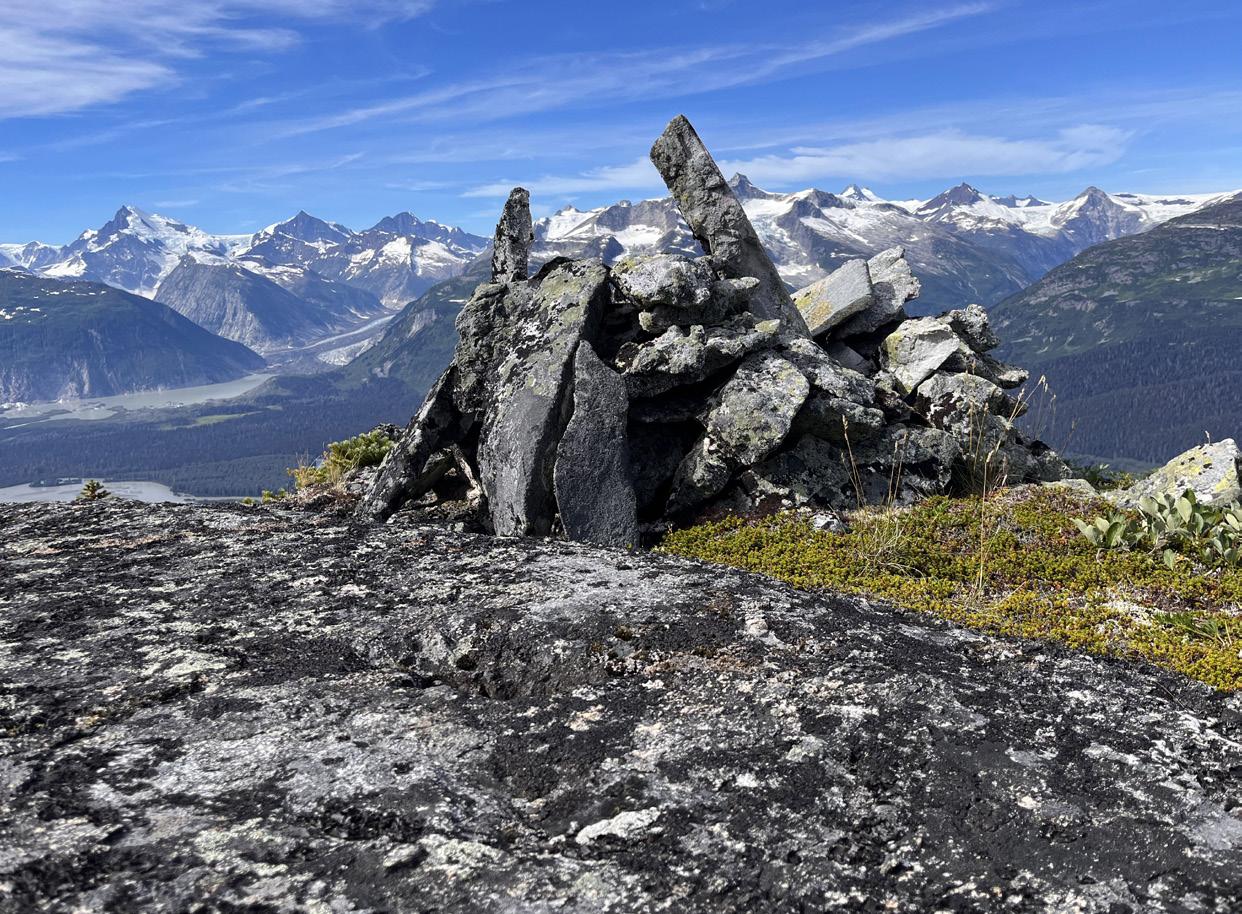
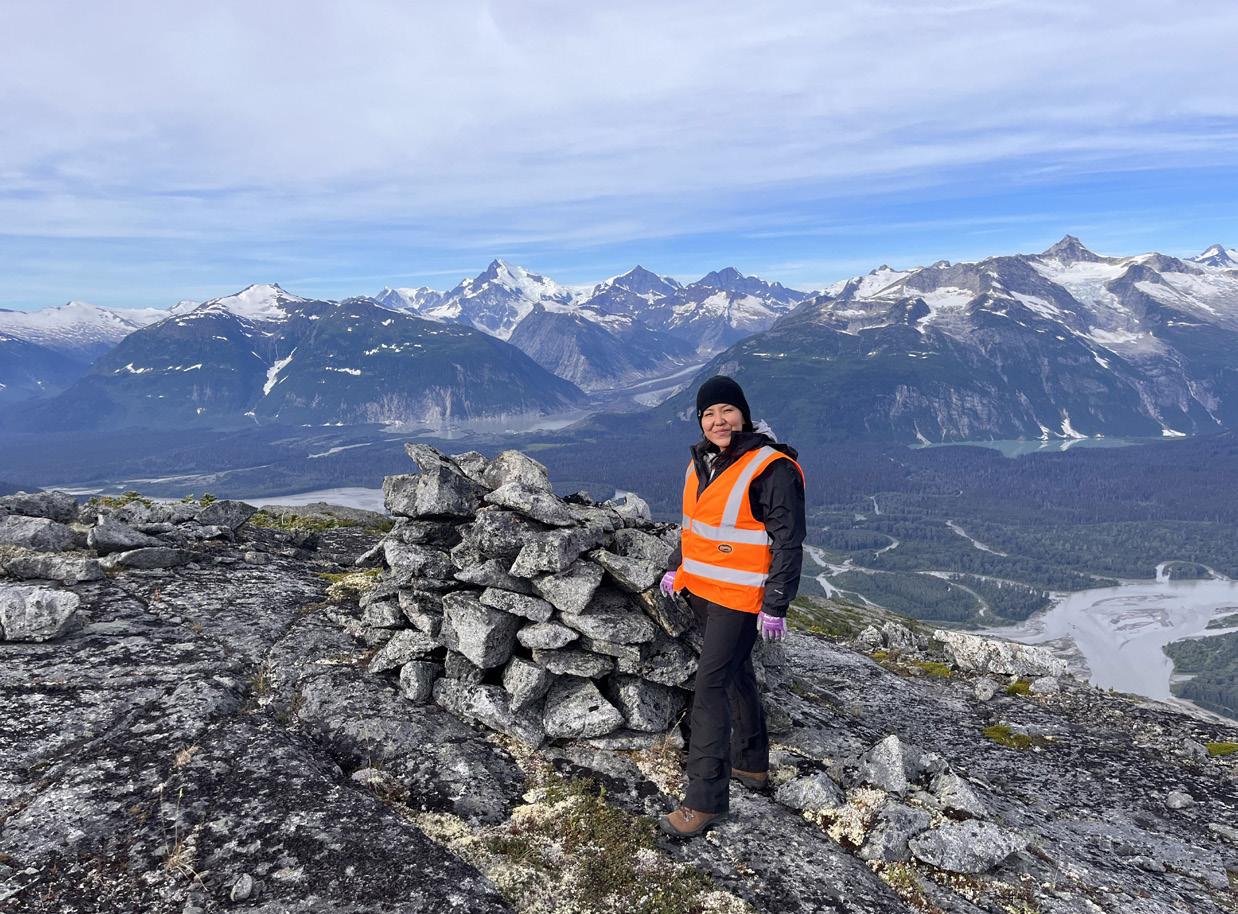
sifting through the dirt over the past few days so we went back to our beds to rest. The next day, we joined everyone down at Tahltan and held a little service for our ancestors while we brought them to a safer place. It was so awesome to see everyone that came out to join us and share this amazing once in lifetime experience. It was truly an honour to be there and help. But we still had not finished our turnaround in Galore Creek, so we had to go back to camp the next day to continue.
My crew was nice enough to let me go home for the night and then they picked me up on the way back to camp. We continued our last days of work in camp getting rides in the helicopter to a safe location near our sites. Then we hiked through thick and dense brush up and along mountain sides and through meadows near Mess Lake. We worked and hiked in the area for three days and then finished up our time in Galore Creek; what a blast! Now we wait to hear back on the data from our AR at Tahltan. I cannot wait for the projects coming up in 2023 in our territory and hope to find out more of our history!
Top: Suzy with one of the cairns.
Middle: Petroform.
Bottom: Lesli Louie and the first cairn recorded.










